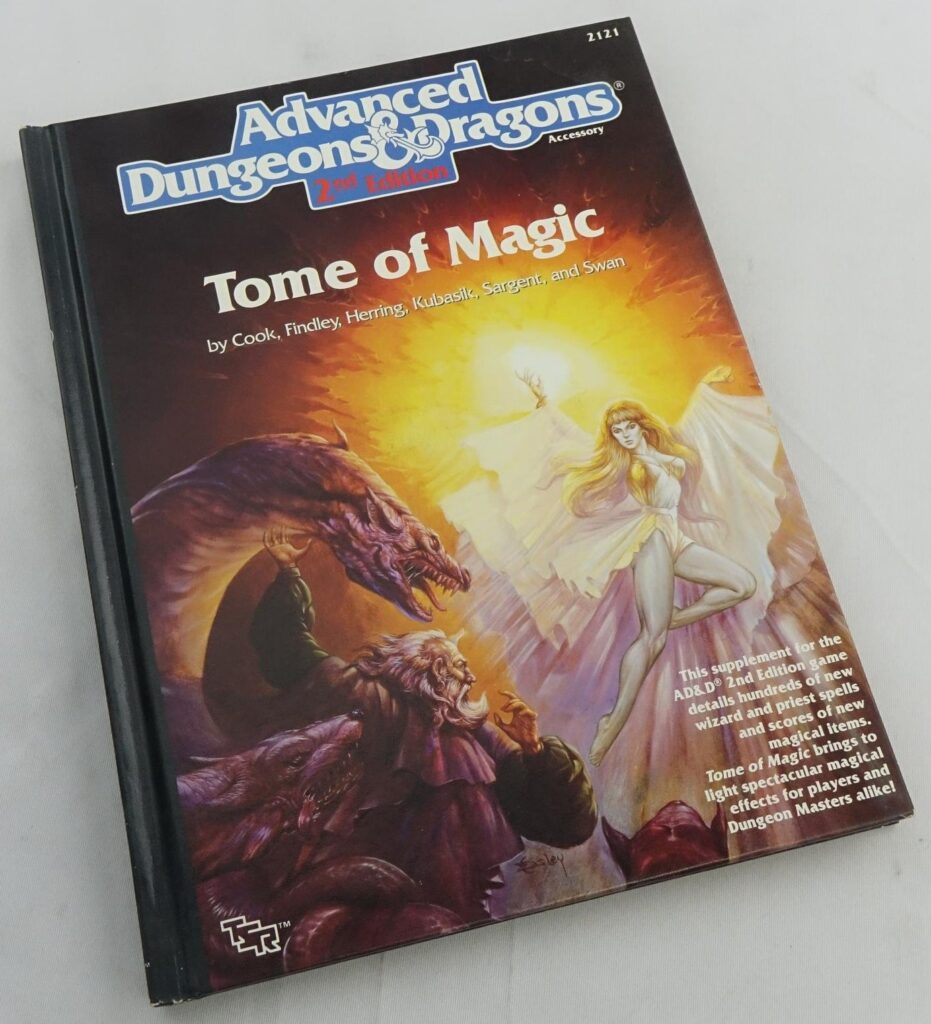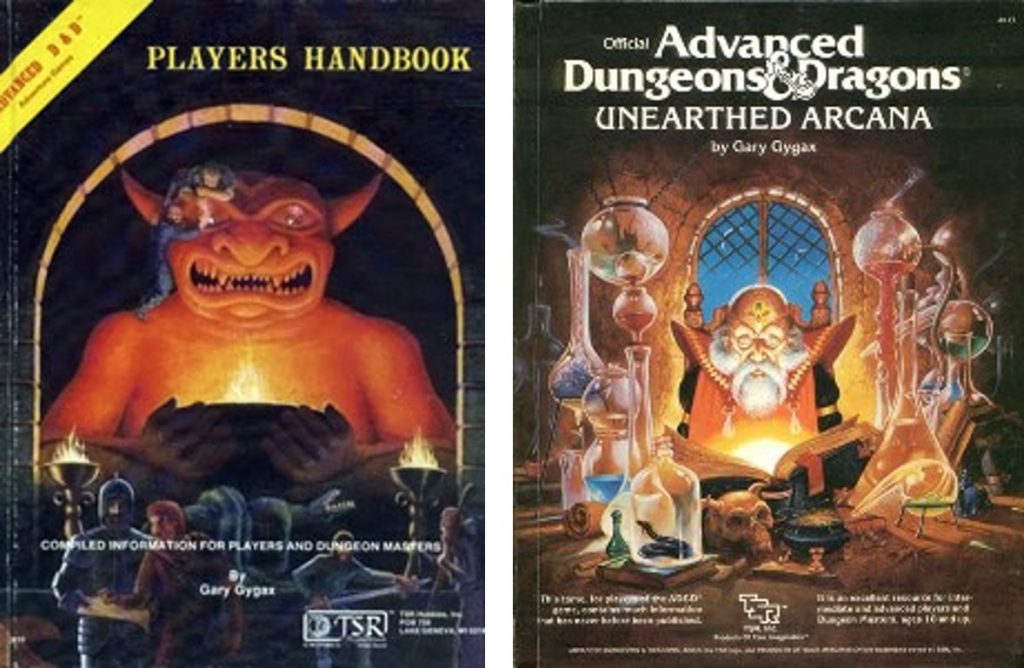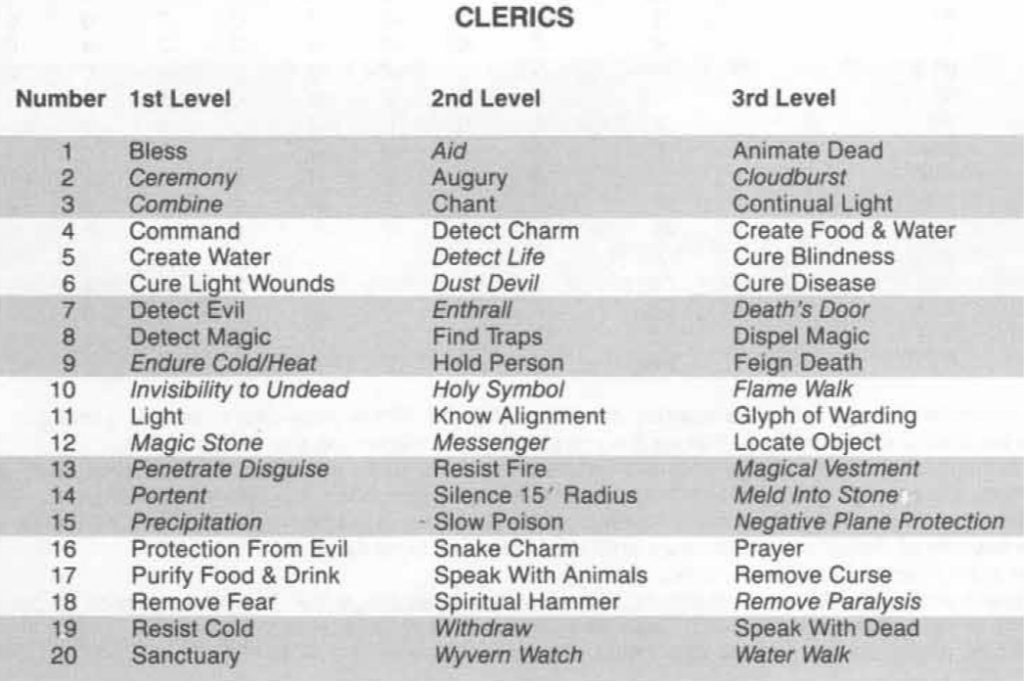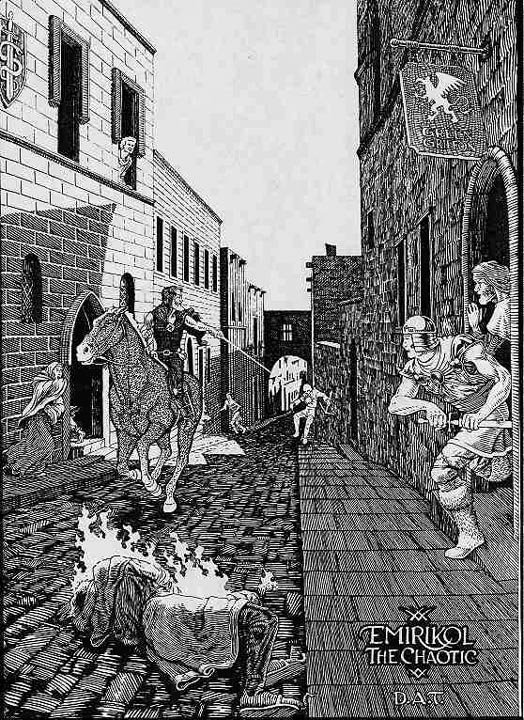THIS POST is part of a series describing the rule changes I’ve made for my current fantasy role-playing campaign. “Kilgore’s Dungeons & Dragons,” or “KD&D,” is a full-fledged variant of the 1st Edition Advanced Dungeons & Dragons game initially released in 1977. Feel free to use some or all of these rule changes for your own D&D gaming, no matter what edition you play.
As I described in the inaugural post to this series, I’m running a 1e AD&D campaign for my friends. While I’ve always enjoyed AD&D, the game system itself can be clunky and difficult, and some parts are, frankly, lame.
To make what I consider to be improvements to the core rules, I’ve borrowed ideas from issues of Dragon magazine and later D&D editions, and have come up with a few of my own. My operating motto for re-tooling the game is to make it, “Simpler & Better.”
In Part 4, I talked about what I did to improve fighters, including paladins and rangers. In Part 5, I covered thieves and assassins. Before I talk about how I improved magic-users and clerics, I need to do a brief aside on spellcasting in general.

As in later editions of D&D, spellcasters in 1e Advanced Dungeons and Dragons got a certain numbers of spells per day, depending on class and level. These spells were chosen by the player, and as the character used them, they ran out. For example, an old-school 1st-level magic-user was able to cast one (and only one) 1st-level spell, and once they shot their wad with it, that was it.
This meant, of course, that low-level spellcasters were pretty weedy compared to other classes. Magic-users were probably the weakest of all, what with their low hit points (d4), inability to wear armor, and their wretched combat abilities.
As spellcasters went up in level, they got the ability to cast more spells per day, and they could cast higher level (thus, more powerful) spells. But getting to that point was hard and frustrating, especially for new players. “Let me get this straight: the paladin can fight all day with his two-handed sword, but I get one Magic Missile spell? That’s it?”
So, for my latest campaign, I rolled up my sleeves and went to work.

Resources
Spells for 1e AD&D were found in the Players Handbook (PHB), Unearthed Arcana (UA), and various issues of Dragon. When 2nd Edition came around, the Tome of Magic (ToM) was released.

The stuff in Dragon and ToM was, for the most part, okay, but nothing so earthshatteringly awesome that players couldn’t live without it. Also, it was a PITA (Pain In The—well, you know) to look up stuff spread out across multiple sources (all those Dragon issues!)
In a nod toward simplicity, it was an easy decision for me to rule that we’d only be using the PHB and UA: the latter nicely adds some more beef to clerics, druids, and illusionists.

Spells Available
Returning to AD&D with refreshed eyes, I noticed a massive imbalance between magic-users (and by extension, illusionists) and clerics (and druids) when it came to the number of spells available at 1st level.
According to the 1e Dungeon Masters Guide (DMG), 1st-level magic-users start off their careers knowing four spells:
- Read Magic;
- An offensive spell (such as Burning Hands, Magic Missile, or Sleep);
- A defensive spell (Feather Fall, Protection From Evil, Shield, etc.); and,
- A miscellaneous spell (Comprehend Languages, Detect Magic, Identify, and so on).
As detailed in Unearthed Arcana, illusionists had a similar arrangement.
In stark contrast, clerics had—again, thanks to UA—20 spells to choose from at 1st level; druids weren’t far behind with 16. WTF?

Furthermore, when the player of a magic-user (or illusionist) was picking which spells to know, they were forced, per the PHB, to roll percentile dice to determine if their character was smart enough to understand each spell. Their chances ranged from 35% (for an Intelligence score of 9) to 85% for 18 Intelligence. “Sorry, Dave, I know you wanted your guy to be able to cast Shocking Grasp, but you blew your roll, so pick something else.” WTF?
As if that wasn’t enough, magic-users (and illusionists) had limits on how many spells of each level they could know. If your DM was a hardcase about rolling up character scores and your magic-user had a mediocre Intelligence (the class’ prime attribute), your wizard or witch might only know a dozen or so for each level, no matter how experienced your character became. WTF?
On the flip side, the cleric (or druid) didn’t need to make any rolls to understand spells, although if they had scores of 12 or lower in Wisdom (the class’ prime attribute), they had a small chance of a spell not going off when the character attempted to cast it. That chance was no higher than 20% for a Wisdom of 9, dropping to 5% at 12 Wisdom, and no chance at higher scores.
In addition, clerics (and druids) got bonus spells for high Wisdom scores. A Wisdom of 13 got you an extra 1st level spell; 14 got you another. Wisdom 15 earned you a bonus 2nd level spell (when your character had advanced enough to cast those), and 16 gave you another 2nd level spell. WIS 17 gave you another 3rd level spell, and WIS 18 gave you a bonus 4th level. And yes, those were cumulative.
And one more thing: clerics and druids didn’t have any limits on how many spells they had available to them. So, yeah, clerics started off with 20 possible 1st level spells, followed by 20 each of 2nd and 3rd level as they raised.

Magic-users and illusionists, however, got one new spell when they advanced, and had to add other spells as they came across them while adventuring (for example, by finding one on a scroll, trading with other wizards, or coming across an ancient spellbook). WTF?
To remedy this, I scaled back and codified how many spells each character class receives at the start: I’ll give details in further posts on each class. One big boost was to give magic-users and illusionists extra spells for higher Intelligence.
Memorizing and Casting Spells
The original AD&D rules stated that spellcasters were required at the beginning of each adventuring day to choose which spells they wanted to use. I tried that in previous campaigns, with the result that clerics took only Cure Light Wounds for all of their 1st-level spells, magic-users only took Fireball or Lightning Bolt as their 3rd-level spells, etc.
The players thought (justifiably so) that they shouldn’t “waste” a spell slot on something as esoteric as Tenser’s Floating Disc, or Mending, instead of taking combat spells like Magic Missile or other, “more useful” spells like Feather Fall.

So, as many Dungeon Masters back in the day did, I ruled that PCs can choose what spell they want to use (from among their collection of known spells) on the fly, as situations develop. The result is that players are more interested in acquiring and using a wider variety of spells, not just the ones that dish out or heal damage.
Cantrips and Orisons. As I mentioned, low-level spellcasters as given under the original rules were pretty much worthless in most circumstances. If your 1st-level magic-user was packing a Sleep spell and you ran into some goblins, then yeah, you were Da Man. If your 1st-level cleric rolled an “8” while using Cure Light Wounds to heal your party’s best fighter, then gold star for you.
Other than that, not so much. This was especially true for newbie magic-users, who were wandering around with one 1st-level spell for the day, which might not be anything better than Light.
To make novices more useful in my latest campaign, I devised/stole the idea of allowing them to cast one (and only one) of their 1st-level spells as many times a day as they wanted (5e D&D does something similar).
For magic-users and illusionists, this spell is considered a cantrip. The choice of spell has to be made at the start of the character’s career, and can’t be switched later. Clerics and druids get the same, with the spell considered an orison.

Yes, I realize that a magic-user can have an unlimited number of Sleep spells, or Magic Missiles; that an illusionist can have unlimited Phantasmal Force spells; clerics with Cure Light Wounds; druids with…whatever it is druids cast.
I view this as a feature, not a bug. Cantrips and orisons make these characters much more useful at low levels, which increases the effectiveness and survivability of their parties: a “rising tide” and “boats” and all that.
At low levels, the casters lean hard on these spells, but as they progress in power, they cast them less frequently, in favor of spells that use slots, but have more ooomph to them.
Recovering Spells
One thing I’ve never liked about AD&D was all the downtime in between when a caster ran out of spells, and when they could start using them again. It was my experience that whenever the magic-user and/or cleric was out of juice, the party shut everything down (if they weren’t up to their eyeballs in Alligator Men, that is).
This was especially irritating at lower levels, when a party had only made it through a few rooms in a dungeon, but then had to camp or leave because their Friendly Neighborhood Prestidigitator had used his single spell for the day.

To get the casters (and thus, their parties) back on the field ASAP, I ruled that they need only rest one hour for the highest spell level that they were trying to recover. So, if all a magic-user was trying to get back was 1st-level spells, it would only take an hour to “recharge,” as it were.
If he/she was trying to get back 3rd-level spells, they would need three hours—but once those three hours were up, they would have all their 1st- and 2nd-level spell slots restored, too. And so on. So, yeah, it would take nine hours before an 18th-level magic-user could cast another Meteor Swarm: I’m good with that.
Material Components
Many spells require material components, bits and ends of odd things: to cast Fireball, for example, the magic-user needs a tiny ball of bat guano and sulfur, or the spell won’t work.
In my current campaign, I assume that the spellcasters have enough of whatever material components they need for an extended period of adventuring, that they acquired them during down time, and that they paid for them out of their standard living expenses.

Some spells have material components which aren’t common items that can be easily purchased or made: Identify, for example, calls for a pearl of at least 100 g.p. value. In keeping with my motto of “Simper & Better,” I’ve ruled that whenever a caster uses a spell that requires an esoteric or expensive item, they just pay for it right when they cast the spell, with the assumption that they bought the component ahead of time.
The only times I would ever get anal about material components would be: 1) if a caster couldn’t afford an item, or 2) if the caster suffered some calamity where they lost all their stuff.
Game Balance
Play-testing has shown me that these changes have made spellcasters much more interesting and effective without unduly affecting game balance. Our group’s cleric has picked Cure Light Wounds as his orison, with the effect that the party can quickly rebound from fights, and the players can continue playing.
It has not resulted in the player-characters being unbeatable. Just because Alphonse can CLW at will doesn’t mean that he can always do it successfully in a fight: I’ve kept the rules about hits interrupting spells as they are being cast. And while healing one of the fighters for 1-8 points is nice and all, it’s not a whole lot of good if said fighter is getting rocked for 25+ points a round by the bad guys.

It is true that previously in the campaign, the illusionist in the party was off the chain with Phantasmal Force, but that was due to bad interpretations of the spell on her part and mine. Illusions have always been difficult to adjudicate in D&D, but I’ve come up with a simple and effective solution. I’ll talk about that at length when I cover the illusionist class in a future update.
Next time, though, I’ll talk specifically about the changes I made for magic-users.
Kenton Kilgore writes killer SF/F for young adults and adults who are still young. His most popular novels are Lost Dogs and Stray Cats, and now you can get them both for one low price in this Kindle box set, available only on Amazon for $4.99!

In Lost Dogs, when our world ends, their struggle begins! After inhuman forces strike without warning or mercy against mankind, Buddy, a German Shepherd, must band with other dogs to find food, water, and shelter in a world suddenly without their owners. But survival is not enough for Buddy, who holds out hope that he can find his human family again.
In Stray Cats, cats really do have nine lives–but they live them all at once, on different worlds. This follow-up to Lost Dogs features the adventures of Pimmi across the multiverse as she faces off against a cosmic menace threatening her and everyone she loves. But against such power, how can one small cat–even with nine lives–prevail?
Included in the boxed set are:
- An alternate ending for Lost Dogs;
- Lost Dogs original (2014) cover art;
- Excerpt from Kenton’s next fantasy novel, The Scorpion & The Wolf (coming 2024);
- Artwork from The Scorpion & The Wolf, by Alyssa Scalia
Dog lovers love Lost Dogs, and fans of felines adore Stray Cats. At last, you can have them both at one low price–get them now!
